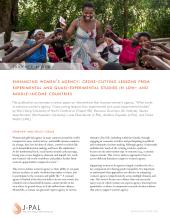Enhancing Women’s Agency: Cross-Cutting Lessons From Experimental and Quasi-Experimental Studies in Low- and Middle-Income Countries
Women’s agency—their ability to define and act on goals, make decisions that matter to them, and participate in the economy and public life—is limited in many contexts around the world. J-PAL’s Evidence Review, “Enhancing Women’s Agency: Cross-Cutting Lessons From Experimental and Quasi-Experimental Studies in Low- and Middle-Income Countries,” highlights key research findings on evidence that cuts across multiple domains of women’s agency and identifies research questions that remain to be answered.
The evidence review summarizes key parts of an academic literature review, “What works to enhance women’s agency: Cross-cutting lessons from experimental and quasi-experimental studies” by Wei Chang (University of North Carolina at Chapel Hill), Eleonora Guarnieri (ifo Institute), Seema Jayachandran (Princeton University), Lucía Díaz-Martin (J-PAL), Akshara Gopalan (J-PAL), and Claire Walsh (J-PAL). The full literature review synthesizes evidence from 160 experimental and quasi-experimental studies.
Key results from the Evidence Review are as follows:
- Gender norms surrounding women’s agency limit the impacts of many interventions that aim to support and empower women.
- Access to financial resources alone, without addressing household dynamics or gender norms, does not consistently improve women’s agency.
- Programs that give women access to resources are more likely to be successful in improving women’s agency if they use design features that give women more control over those resources.
- For young women, some economic interventions were effective in delaying the timing of marriage and childbearing. Changing household dynamics after marriage seems more challenging.
- Programs designed to relieve multiple constraints that women face are frequently effective in improving women’s agency. These programs often include elements that raise awareness of gender dynamics or develop soft or life skills. However, more research is needed on cost-effectiveness along with which program elements drive impacts and how.
- Some approaches that improve women’s agency across multiple domains include the following: 1) adolescent girls’ programs that enhance girls’ soft and life skills; 2) laws that mandate gender equality by protecting women’s property rights, removing labor restrictions, or guaranteeing women’s representation in politics; 3) cash and in-kind transfer programs that enhance women’s agency in marriage and childbearing decisions or protect women against violence; and 4) the intensive, multifaceted “Graduation” approach originally developed by the nongovernmental organization (NGO) BRAC.
Table illustrating the strength of the evidence:
This table is organized by the intervention types identified in the evidence review. It illustrates the strength of the evidence which suggests that each intervention type impacts the different indicators of women’s agency. It covers all the indicators of women’s agency discussed in the evidence review, including direct indicators such as”power within” (i.e., self-efficacy, aspirations, and attitudes towards gender norms), household decision making power, freedom of movement, and freedom from violence; as well as indirect indicators of agency in the family, economic, and community & political domains.
